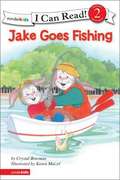- Table View
- List View
Italian Ecocinema Beyond the Human (New Directions in National Cinemas)
by Elena PastEntangled in the hybrid fields of ecomedia studies and material ecocriticism, Elena Past examines five Italian films shot on location and ponders the complex relationships that the production crews developed with the filming locations and the nonhuman cast members. She uses these films—Red Desert (1964), The Winds Blows Round (2005), Gomorrah (2008), Le quattro volte (2010), and Return to the Aeolian Islands (2010)—as case studies to explore pressing enviornmental questions such as cinema's dependence on hydrocarbons, the toxic waste crisis in the region of Campania, and our reliance on the nonhuman world. Dynamic and unexpected actors emerge as the subjects of each chapter: playful goats, erupting volcanoes, airborne dust particles, fluid petroleum, and even the sound of silence. Based on interviews with crew members and close readings of the films themselves, Italian Ecocinema Beyond the Human theorizes how filmmaking practice—from sound recording to location scouting to managing a production—helps uncover cinema's ecological footprint and its potential to open new perspectives on the nonhuman world.
Italian Ecocinema: Beyond the Human (New Directions in National Cinemas)
by Elena PastEcocriticism and film studies unite in this examination of five Italian films and the environmental questions they raise.Entangled in the hybrid fields of ecomedia studies and material ecocriticism, Elena Past examines five Italian films shot on location and ponders the complex relationships that the production crews developed with the filming locations and the nonhuman cast members. She uses these films—Red Desert (1964), The Winds Blows Round (2005), Gomorrah (2008), Le quattro volte (2010), and Return to the Aeolian Islands (2010)—as case studies to explore pressing environmental questions such as cinema’s dependence on hydrocarbons, the toxic waste crisis in the region of Campania, and our reliance on the nonhuman world. Dynamic and unexpected actors emerge as the subjects of each chapter: playful goats, erupting volcanoes, airborne dust particles, fluid petroleum, and even the sound of silence. Based on interviews with crew members and close readings of the films themselves, Italian Ecocinema Beyond the Human theorizes how filmmaking practice—from sound recording to location scouting to managing a production—helps uncover cinema’s ecological footprint and its potential to open new perspectives on the nonhuman world.“[Past] uniquely and innovatively combines film studies and material ecocriticism with a focus on Italy. Such weaving of tales brings the films to life and reads them as ecological documents and Italian stories.” —Heather I. Sullivan, author of The Intercontextuality of Self and Nature in Ludwig Tieck’s Early Works“A timely and incisive study that interrogates a new, though growing, trend in film criticism and makes an important and rich contribution to Italian film studies, Italian cultural studies, and ecocriticism.” —Bernadette Luciano, author (with Susanna Scarparo) of Reframing Italy: New Trends in Italian Women’s Filmmaking“Part memoir, part close analysis of the films themselves, and illustrated with numerous excellent frame grabs, Past’s book casts a dreamlike spell as it contemplates the past, present, and future of the cinema and moves smoothly between environmental issues and aesthetic and practical concerns.” —Choice
Italian Ecocinema: Beyond the Human (New Directions in National Cinemas)
by Elena PastEcocriticism and film studies unite in this examination of five Italian films and the environmental questions they raise.Entangled in the hybrid fields of ecomedia studies and material ecocriticism, Elena Past examines five Italian films shot on location and ponders the complex relationships that the production crews developed with the filming locations and the nonhuman cast members. She uses these films—Red Desert (1964), The Winds Blows Round (2005), Gomorrah (2008), Le quattro volte (2010), and Return to the Aeolian Islands (2010)—as case studies to explore pressing environmental questions such as cinema’s dependence on hydrocarbons, the toxic waste crisis in the region of Campania, and our reliance on the nonhuman world. Dynamic and unexpected actors emerge as the subjects of each chapter: playful goats, erupting volcanoes, airborne dust particles, fluid petroleum, and even the sound of silence. Based on interviews with crew members and close readings of the films themselves, Italian Ecocinema Beyond the Human theorizes how filmmaking practice—from sound recording to location scouting to managing a production—helps uncover cinema’s ecological footprint and its potential to open new perspectives on the nonhuman world.“[Past] uniquely and innovatively combines film studies and material ecocriticism with a focus on Italy. Such weaving of tales brings the films to life and reads them as ecological documents and Italian stories.” —Heather I. Sullivan, author of The Intercontextuality of Self and Nature in Ludwig Tieck’s Early Works“A timely and incisive study that interrogates a new, though growing, trend in film criticism and makes an important and rich contribution to Italian film studies, Italian cultural studies, and ecocriticism.” —Bernadette Luciano, author (with Susanna Scarparo) of Reframing Italy: New Trends in Italian Women’s Filmmaking“Part memoir, part close analysis of the films themselves, and illustrated with numerous excellent frame grabs, Past’s book casts a dreamlike spell as it contemplates the past, present, and future of the cinema and moves smoothly between environmental issues and aesthetic and practical concerns.” —Choice
Italy and the Environmental Humanities: Landscapes, Natures, Ecologies (Under the Sign of Nature: Explorations in Ecocriticism)
by Serenella Iovino, Enrico Cesaretti, and Elena PastBringing together new writing by some of the field’s most compelling voices from the United States and Europe, this is the first book to examine Italy--as a territory of both matter and imagination--through the lens of the environmental humanities. The contributors offer a wide spectrum of approaches--including ecocriticism, film studies, environmental history and sociology, eco-art, and animal and landscape studies--to move past cliché and reimagine Italy as a hybrid, plural, eloquent place. Among the topics investigated are post-seismic rubble and the stratifying geosocial layers of the Anthropocene, the landscape connections in the work of writers such as Calvino and Buzzati, the contaminated fields of the ecomafia’s trafficking, Slow Food’s gastronomy of liberation, poetic birds and historic forests, resident parasites, and nonhuman creatures. At a time when the tension between the local and the global requires that we reconsider our multiple roots and porous place-identities, Italy and the Environmental Humanities builds a creative critical discourse and offers a series of new voices that will enrich not just nationally oriented discussions, but the entire debate on environmental culture. Contributors: Marco Armiero, Royal Institute of Technology at Stockholm * Franco Arminio, Writer, poet, and filmmaker * Patrick Barron, University of Massachusetts * Damiano Benvegnù, Dartmouth College and the Oxford Center for Animal Ethics * Viktor Berberi, University of Minnesota, Morris * Rosi Braidotti, Utrecht University * Luca Bugnone, University of Turin * Enrico Cesaretti, University of Virginia *Almo Farina, University of Urbino * Sophia Maxine Farmer, University of Wisconsin-Madison * Serena Ferrando, Colby College * Tiziano Fratus, Writer, poet, and tree-seeker * Matteo Gilebbi, Duke University * Andrea Hajek, University of Warwick * Marcus Hall, University of Zurich * Serenella Iovino, University of Turin * Andrea Lerda, freelance curator * Roberto Marchesini, Study Center of Posthuman Philosophy in Bologna * Marco Moro, Editor-in-Chief of Edizioni Ambiente, Milan * Elena Past, Wayne State University * Carlo Petrini, Founder of International Slow Food Movement * Ilaria Tabusso Marcyan, Miami University (Ohio)* Monica Seger, College of William and Mary * Pasquale Verdicchio, University of California, San Diego
Italy in a European Context: Research In Business, Economics, And The Environment
by Donatella Strangio Giuseppe SancettaItaly in a European Context
Itsy Bitsy and Teeny Weeny
by Robbyn Smith van FrankenhuyzenOne spring, as part of their animal rescue work on Hazel Ridge Farm, Gijsbert (Nick) and Robbyn van Frankenhuyzen find themselves caring for a lamb (rejected by its mother) and an orphaned fawn at the same time. They name the lamb Teeny Weeny and the fawn Itsy Bitsy. It's touch-and-go for the first two weeks as the infants' health is precarious and they require almost round-the-clock attention from Robbyn. But as their good health increases, so do their energy levels! Raised as siblings, the two youngsters are inseparable, sharing a playpen in the house, romping together, and just getting into general mischief Eventually, summer comes and goes and moves into fall. And as the seasons change, Itsy Bitsy and Teeny Weeny grow into their true selves, away from "Mother" Robbyn and each other. Nature must take its course and the two animals go their separate ways: One back to a life in the wild and the other on to domestic farm life. Warmly illustrated by wildlife artist Gijsbert van Frankhuyzen, this bittersweet story is another gentle lesson in how nature works . . . on Hazel Ridge Farm. Itsy Bitsy & Teeny Weeny is the fourth entry in the Hazel Ridge Farm wildlife series.
It’s All for Sale: The Control of Global Resources
by James RidgewayFive companies dominate the U.S. petroleum industry. Five control the worldwide trade in grain. Two have a corner on the private market for drinking water. In terms of actual dollars, trade in heroin, cocaine, and tobacco ranks alongside that in grain or metals. There are more slaves in the world today than ever before. Resource by resource, It's All for Sale uncovers and discloses who owns, buys, and sells what. Some resources--such as fuel, metals, fertilizers, drugs, fibers, food, forests, and flowers--have, for better or worse, long been thought of as commodities. Others--including fresh water, human beings, the sky, the oceans, and life itself (in the form of genetic codes)--are more startling to think of as products with price tags, but, as James Ridgeway shows, they are treated as such on a massive scale in lucrative markets around the world. Revealing the surprisingly small number of companies that control many of the basic commodities we use in everyday life, It's All for Sale confirms in specific detail that globalization has been accompanied by an extraordinary concentration of ownership. At the same time, it is about much more than what company has cornered the market in corn or diamonds. Corporations and captains of industry, wars and swindles, oppressors and the oppressed, empires and colonies, military might and commercial power, economic boom and bust--all these come alive in Ridgeway's canny and arresting reporting about the global scramble for power and profit. It's All for Sale is an invaluable source for researchers, activists, and all those concerned with globalization, corporate power, and the exploitation of individuals and the environment.
Ivy and Bean What's the Big Idea? (Ivy + Bean #7)
by Annie Barrows Sophie BlackallIn this seventh entry in the New York Times–bestselling series, two unlikely best friends get creative as they prepare for the Science Fair.It’s the Science Fair, and the second grade is all over it! Some kids are making man-eating robots. Some kids are holding their breath for a very, very long time. Some kids are doing interesting things with vacuum cleaners. The theme, obviously, is global warming. But what should Ivy and Bean do? Something involving explosions? Or ropes? Something with ice cubes? Or maybe . . . maybe something different.Praise for What’s the Big Idea?“This seventh episode about unlikely best friends Ivy and Bean may be the most ambitious and triumphant yet . . . . Barrows and Blackall know just how to expose situations that are familiar to second-graders—with empathy and a light touch.” —Shelf-Awareness
Iwígara: American Indian Ethnobotanical Traditions and Science
by Enrique SalmónTap into Thousands of Years of Plant Knowledge The belief that all life-forms are interconnected and share the same breath—known in the Rarámuri tribe as iwígara—has resulted in a treasury of knowledge about the natural world, passed down for millennia by native cultures. Ethnobotanist Enrique Salmón builds on this concept of connection and highlights 80 plants revered by North America&’s indigenous peoples. Salmón teaches us the ways plants are used as food and medicine, the details of their identification and harvest, their important health benefits, plus their role in traditional stories and myths. Discover in these pages how the timeless wisdom of iwígara can enhance your own kinship with the natural world.
JFK's Secret Doctor: The Remarkable Life of Medical Pioneer and Legendary Rock Climber Hans Kraus
by Susan E.B. SchwartzSet against the grand panorama of twentieth-century world events, it captures the remarkable life and spirit of climbing and medical visionary Hans Kraus (1905-1966). Kraus was taught English by James Joyce, escaped Nazi dominated Europe, and was JFK’s secret back specialist. A legendary rock climber known for hair-raising ascents on two continents, Kraus lived a life filled with tragedy and triumph, intense passion, verve, and a whole lot of guts, glory, and wit. One of the great unsung medical pioneers of the twentieth century, Kraus made headline news throughout the second half of the 1950s, was a guest of honor at Eisenhower’s White House, and was the subject of cover stories in major magazines throughout America, including Sports Illustrated. His pioneering work in muscles and fitness uncovered a shocking truth about a lack of fitness in American children, and his work curing back pain brought him into the Kennedy White House and inner circle of Camelot. Here now is the life of Hans Kraus, including the behind-the-scenes story of Kennedy’s crippling back problems, based on new documentation, including White House medical records and interviews with two Kennedy White House doctors. Skyhorse Publishing, as well as our Arcade imprint, are proud to publish a broad range of books for readers interested in history--books about World War II, the Third Reich, Hitler and his henchmen, the JFK assassination, conspiracies, the American Civil War, the American Revolution, gladiators, Vikings, ancient Rome, medieval times, the old West, and much more. While not every title we publish becomes a New York Times bestseller or a national bestseller, we are committed to books on subjects that are sometimes overlooked and to authors whose work might not otherwise find a home.
Jack y Jill y el gran perro Bill (LEYENDO A PASOS (Step into Reading))
by Martha WestonDale la bienvenida al invierno con este álbum ilustrado en español acerca de un día nevado. ¡Es perfecto para pequeños que comienzan a leer solos!Jack y Jill y el gran perro Bill pasean en su trineo en un día de invierno. Cuando el gran perro Bill ve a un conejo en la colina, esto causa un caos. Esta divertida historia está llena de aliteración, rima y nieve . . . muchísima nieve. LEYENDO A PASOS es una línea de Step into Reading que ofrece ediciones en español de libros nivelados. Los libros Paso 1 tienen letra grande y palabras fáciles. Son ideales para niños que conocen el abecedario y que quieren comenzar a leer. Su ritmo, rima y pistas visuales contribuyen a la comprensión del texto. This snowy Step 1 reader gets the Spanish treatment! Jack and Jill and big dog Bill go sledding one snowy winter day. When big dog Bill notices a rabbit on the hill, mayhem ensues. This fun early reader in Spanish is filled with alliteration, rhyme, and snow . . . so much snow! Step 1 Readers feature big type and easy words for children who know the alphabet and are eager to begin reading. Rhyme and rhythmic text paired with picture clues help children decode the story. LEYENDO A PASOS is a Spanish-language line of Step into Reading.
Jackals, Golden Wolves, and Honey Badgers: Cunning, Courage, and Conflict with Humans (Routledge Studies in Conservation and the Environment)
by Keith SomervilleThis book explores the fascinating and complex lives of the honey badger, the African jackals (black-backed and side-striped), African golden wolves, and Eurasian golden jackals. In recent years, interest in these creatures has grown exponentially, through wildlife documentaries and media clips showing the aggressive, fearless, and tenacious behaviour of the honey badger, with jackals often presented in a supporting role. Written by renowned journalist and educator Keith Somerville, this accessible volume includes historical narratives, folklore, and contemporary accounts of human–wildlife relationships and conflicts. It traces the evolution of the species; their foraging and diet; the development of their relationships with humans; and their commensal, kleptocratic, and symbiotic relationships with other carnivores, raptors and birds. It also charts the recent expansion in European jackal numbers and ranges, now including as far west as the Netherlands and as far north as Finland. Blending historical observations by non-scientists, colonial officials, administrators, and early conservationists with contemporary scientific accounts, it presents a new multidisciplinary approach that will interest researchers, scientists, and students in wildlife conservation, human–wildlife relations, zoology, biology, and environmental science.
Jacky Ha-Ha Gets the Last Laugh (Jacky Ha-Ha #3)
by James Patterson Chris GrabensteinJacky Ha-Ha is off to theater camp and funnier than ever in this hilarious illustrated novel from James Patterson and Chris Grabenstein's #1 New York Times bestselling series. Jacky Hart finally knows the thrill of having people laugh with her (not at her). She tries to put her comedy and theater skills to use in her summer job, but the boardwalk crowds aren&’t exactly adoring. So Jacky jumps at the opportunity of a lifetime: an all-expense paid trip to theater camp! When Jacky gets to Camp Footlights, she realizes she&’s way out of her depth. The highly trained campers all seem to know everything about performing, and exactly how to command the spotlight. All Jacky wants is to prove she fits in, but the more she tries, the more she stands out—and not in a good way. With help from her new friends, can Jacky Ha-Ha earn her place in the spotlight…or will she flop? Packed with illustrations, jokes, and hijinks, the latest book in the #1 bestselling Jacky Ha-Ha series delivers a hilarious and heartwarming dose of summer fun, perfect for reading all year round!
Jacob van Ruisdael’s Ecological Landscapes (Visual and Material Culture, 1300-1700)
by Catherine LevesqueThis book examines Jacob van Ruisdael's treatment of five subjects—dunes, grainfields, ruins, rushing water, and woodlands—that recur throughout his career. The paintings, though fictive, show close attention to the complexities of particular environments that can be fruitfully considered “ecological.” The pattern of Ruisdael’s reworking each environment and associated phenomena shows him as laboring over these themes. His work across media conveys something of his demanding and methodical procedure as he sought to achieve pictorially the force, temporality, vitality, and motion of nature. Ruisdael’s paintings decenter humankind within familiar yet reimagined landscapes. His ability to depict nature’s dynamism provided an alternative vision at a foundational moment when landscape, increasingly manipulated and controlled, was most often considered property and investment. His focus on the techniques and processes of his own work to render these entities was essential to his ecological perspective and invites a similar recognition from an attentive viewer.
Jacob's Wound: A Search for the Spirit of Wildness
by Trevor HerriotThe award-winning author of River in a Dry Land explores the Nature that we - and our religions - sprang from The Genesis story of Jacob, the patriarch of the Judeo-Christian tradition, wrestling with a spirit has been interpreted in a multitude of ways, but never more persuasively than by Trevor Herriot in Jacob's Wound. He sees it as a struggle between Jacob and his wilder twin brother, Esau, whose birthright Jacob has swindled. The central idea of Herriot's brilliantly written, observant, and groundbreaking book is the wound that Jacob, the farmer, the civilized man, suffered in vanquishing Esau, the hunter, the primitive man. And the central question posed is whether we, as Jacob did with Esau, can eventually reconcile with the wildness we conquered and have been estranged from for so long.As if ambling through the author's beloved Qu'Appelle Valley in Saskatchewan, Jacob's Wound takes readers on an untrodden path through history, memoir, science, and theology. Along the way, Herriot tells us stories of the past and present that illuminate what we once were and what we have become. It's a measured journey motivated by curiosity rather than by destination, and at every turn there is insight and beautiful writing.
Jacques Cousteau: The Sea King
by Brad MatsenIn this balanced biography of Cousteau (1910-1997), Matsen (an author specializing in marine subjects) traces the life and contributions of the renowned marine explorer/filmmaker/ conservationist from his development of the Agua-Lung and undersea photography equipment to his public television documentary series, The Undersea World of Jacques Cousteau, and legal battles between his heirs. The book includes photographs of Cousteau, his two families, well-known ship The Calypso, scientific expeditions, and monument in his hometown in France. Annotation c2010 Book News, Inc. , Portland, OR (booknews. com)
Jaguar
by Helen CowcherReaders will learn about nature's delicate balance in the rain forest and facts about the many animals that live there in this book.
Jaguar
by Roland SmithWhile on a trip up the Amazon River going to a jaguar preserve with his father, 14-year-old Jake must contend with dangerous animals and fortune hunters.
Jainism and Environmental Politics (Routledge Focus on Environment and Sustainability)
by Aidan RankinThis book explores the ways in which the ecologically centred Indian philosophy of Jainism could introduce a new and non-western methodology to environmental politics, with the potential to help the green movement find new audiences and a new voice. Aidan Rankin begins with a description of the ideas and principles that distinguish Jainism from other Indian (and western) philosophies. He goes on to compare and contrast these principles with those of current environmental politics and to demonstrate the specific ways in which Jain ideas can assist in driving the movement forward. These include the reduction of material consumption, the ethical conduct of business within sustainable limits, and the avoidance of exploitative relationships with fellow humans, animals and ecosystems. Overall, the book argues that Jain pluralism could be a powerful tool for engaging non-western societies with environmental politics, allowing for an inclusive approach to a global ecological problem. This book will be of great interest to students and scholars of environmental politics, environmental philosophy, comparative religions and Jainism.
Jak's Story
by Aaron BellThirteen-year-old Jak Loren is a typical boy with the usual problems a family with older sisters and younger brothers presents. Never mind the troubles at school - bullies and girls! When Jak goes to the ravine near his home in Brantford to get away from Steven Burke, a bully who’s been tormenting him, he discovers the ravine has a history that’s much older than he thought. He meets Grandfather Rock, who shares with him the story of the people who have lived near the ravine for thousands of years. Soon Jak’s eyes are opened to a new world of beings and respect. He learns about First Nations people and how their teachings inhabit the spirits of all living things that surround us even today. The tales of the First Nations help Jak to understand that the gift of life is something to be cherished. And when a construction crew arrives in his neighbourhood and threatens his beloved ravine, Jak knows he has to act to save it.
Jakarta: 25 Excursions in and Around the Indonesian Capital
by Melanie Wood Andrew WhitmarshLinking over 500 activities and attractions into 25 half-day and full-day excursions, this is the first in-depth book on Jakarta that tells you exactly where to go, what to do and how to get there in order to maximize your enjoyment of the city.
Jake Goes Fishing (I Can Read! #Level 2)
by Crystal BowmanSpilled worms and a snagged hook threaten to ruin Jake's fishing trip. He wants to have fun with his father. But what if there are no fish to bring home for dinner? Although he makes some mistakes at first, Jake spends a wonderful day fishing with his father, then enjoying a very special fish dinner. Picture descriptions present.
Jake and the Quake
by Cary SneiderWhen Jake finds an unusual rock in the cliffs under the Golden Gate bridge, he embarks on an adventure of discovery that will bring him new friends, new knowledge, and even the confidence to face a devastating earthquake.
Jam and Jelly: A Step-by-Step Kids Gardening and Cookbook (Grow Your Own Ingredients #1)
by Cassie LiversidgeGrow It! Harvest it! Cook it! Eat it! Yummy Jam and Jelly for You and Your Family! There is nothing like eating homemade jam and jelly. Now you can learn how to grow the plants they come from and then make your own. Strawberry jam, pumpkin jam, mint jelly, and rhubarb jelly are perfect for so many occasions, from summer picnics to weekend breakfasts and everyday snacks. You will learn how to grow strawberries, pumpkins, mint, and rhubarb with the fun instructions inside. Then you can harvest your ingredients and head to the kitchen to learn how to transform them into these delicious treats! They can make very special gifts, as well, if you can bear to part with them. Have fun getting your hands dirty while growing your own ingredients. Most of all, get ready to eat the best food in the world—food you have grown it yourself! This is the third book in the Grow Your Own series, after Pasta Sauce! and Ice Cream!
James Herriot's Dog Stories
by James HerriotFrom the Book Jacket "[Herriot has the] ability to touch readers with his stories of pets and their eccentric owners and to bring them into the harshly beautiful world of the Yorkshire dales." -Chicago Tribune "FIFTY TOUCHING AND MEMORABLE DOG STORIES FROM THE VETERINARIAN AND MASTER STORYTELLER OF YORKSHIRE . . . AN EXTRA SPECIAL TREAT!" -Kirkus Reviews "Herriot's real gift lies in keeping us intrigued with his human and dog characters . . . Herriot teaches us how unpredictable and joyous life can be." -San Francisco Chronicle "James Herriot has become one of America's most beloved storytellers." -Times-Dispatch (Richmond, VA)




